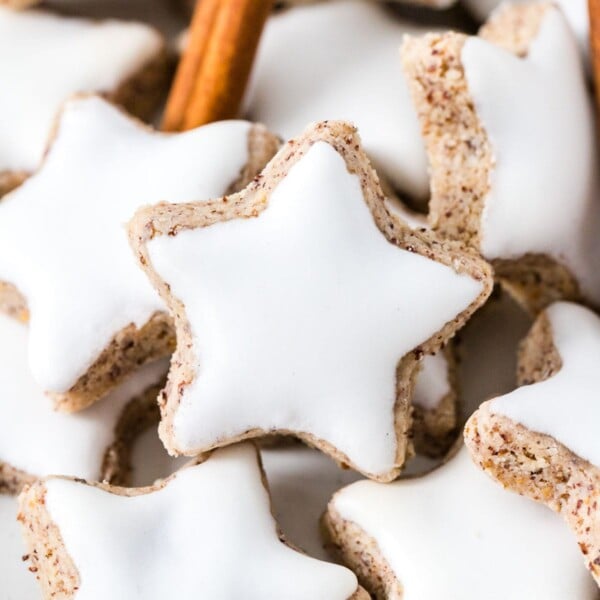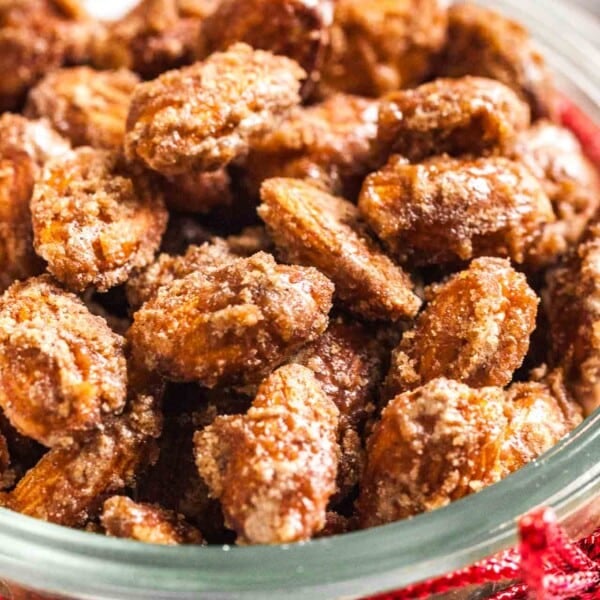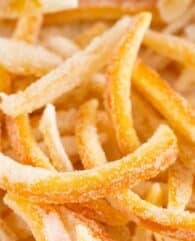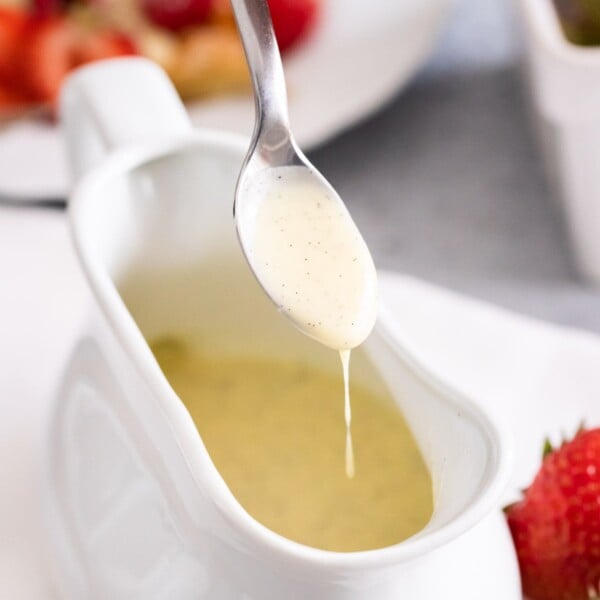This post may contain affiliate links.Please read our disclosure policy.
Candied orange peel makes a delicious snack, especially dipped in chocolate, but is also an important ingredient in German Christmas baking!

Making candied peel at home takes some time but is also very simple – you only need a few ingredients and the result tastes so much better than store bought! The orange peels are cooked in sugar syrup and then rolled in sugar. They taste sweet and have a strong orange flavor, which is perfect for baking.
Candied orange (Orangeat in German) and lemon peel (Zitronat in German) are important ingredients in many German Christmas recipes, for example in our Lebkuchen (German Gingerbread) recipe and German Stollen recipe. But you can also use it in scones, cakes, and fruitcakes or dip it in chocolate for a tasty homemade gift.
Why you’ll love this recipe
- Candied peel is often hard to find or can only be found at specialty stores or online, so making it at home from scratch is often the only way to get your hands on it
- It tastes so much better and fresher than store bought, and you know exactly what’s in it
- You can use it in a variety of recipes from Lebkuchen to Scones, but it also makes a delicious snack
Ingredient notes
Here is an overview of the ingredients you’ll need for this recipe. Scroll down to the recipe card at the bottom for quantities.
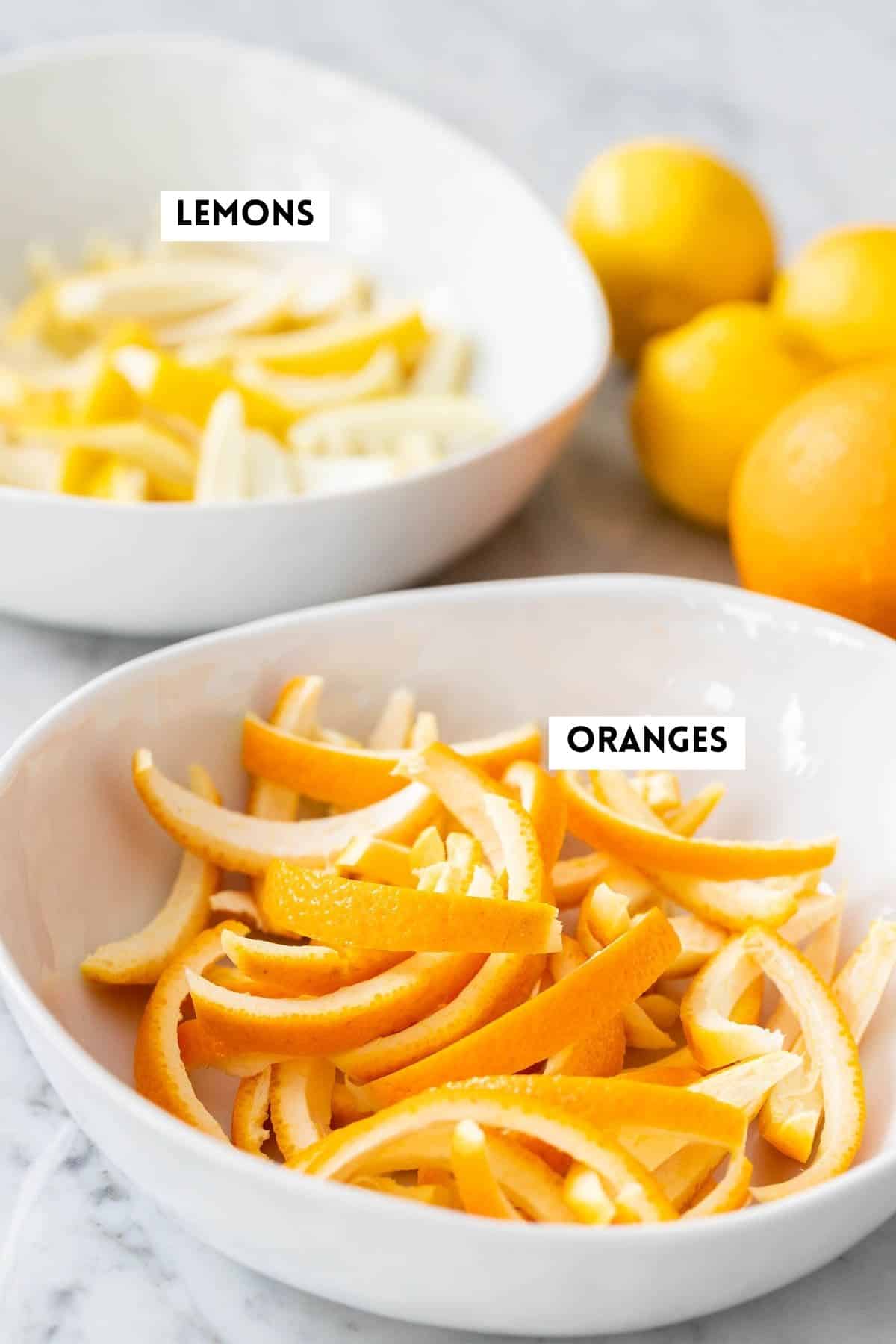
- Oranges – This recipe works best with organic oranges because the peel tastes better and is not treated with pesticides. I usually use Navel oranges or Valencia oranges.
- Lemons – This recipe can also be used for lemons or limes and other citrus fruit. Organic is best.
How to make this recipe
Detailed measurements and instructions can be found at the bottom of the page on the printable recipe card.
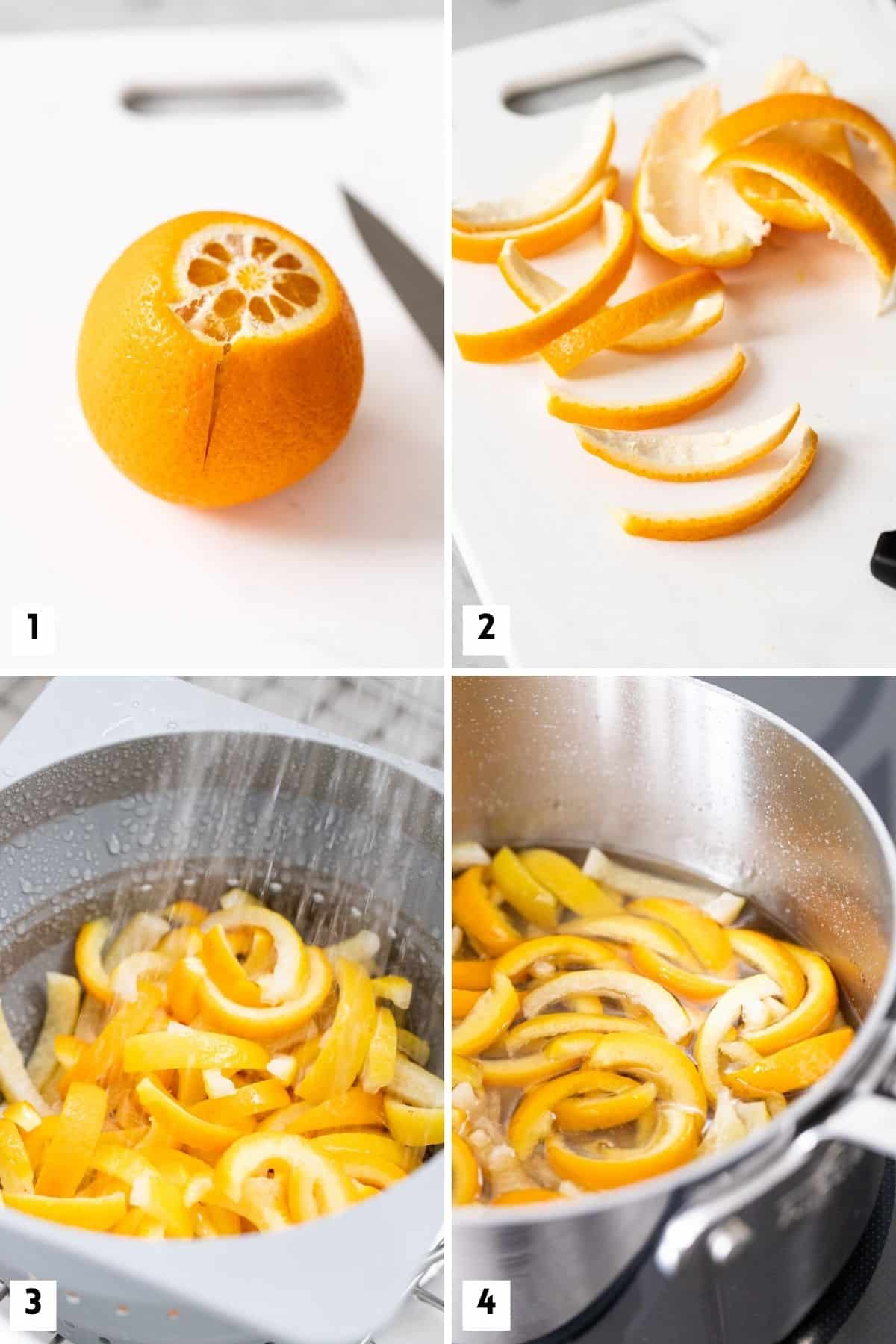
Start by washing your oranges with hot water. Then cut off the top and bottom and score the peel in quarters (Image 1). Gently peel the orange then cut the peels into stripes about 1/4-inch wide (Image 2).
Place the stripes in a medium saucepan, cover with cold water, and bring to a boil. Drain and rinse them, then repeat the process once or twice (Images 3 and 4).
In the same saucepan, combine the sugar and cup of water. Bring to a boil, then add the peels and simmer for about 60 minutes, until the peels are translucent (Image 5). Remove the peels, let excess syrup drip off, and spread them out on a wire rack to cool down (Images 6 and 7).
Then roll them in sugar or put them in a ziplock bag with the sugar and toss the bag until the peels are coated in sugar. Spread the out on a wire rack to dry for one or two days until they’re completely dry (Image 8).
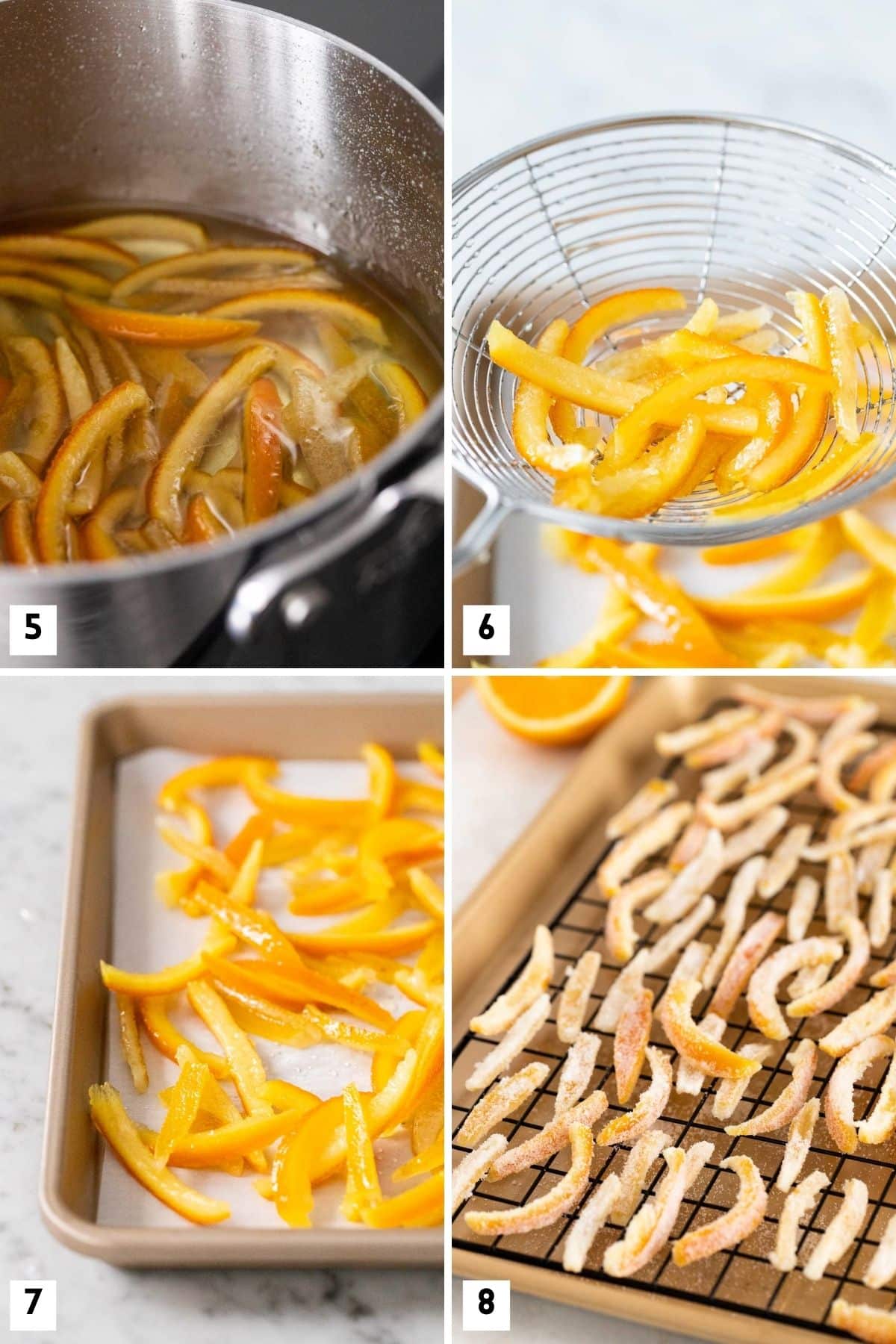
Expert tips for success
- Citrus fruit: You can make this recipe with any citrus fruit. I use oranges and lemons. But it also works with limes and grapefruits.
- Blanching: Don’t skip blanching the peels! This process diminishes the bitterness of the pith, the white part of the peel, and also gives the final product a soft and chewy texture.
- Sugar mixture: You want the citrus peels to be covered with syrup. If your oranges are very large, and you have a lot of peel, you can increase the amount of water and sugar by the same ratio.
- Candy Thermometer: On a candy thermometer the target temperature of the sugar mixture is about 230 degrees F which is soft ball stage.
- Pith: Don’t remove too much of the pith because the thinner the peels, the harder and tough the candied orange will be. You want it to be slightly chewy.
- Leftover fruit: The peeled fruit can be used for eating or juicing, it is not needed for the recipe.
- Drying: It takes a few days until the peels are dry. I recommend turning them a once a day. You can also transfer them to a parchment paper-lined baking tray after they are cooled down.
- Baking: If you want to use the peel for baking, I recommend not rolling it in sugar. Just skip that step and let the peel dry until they are just dry enough.
- Syrup: The strained syrup is essentially a citrus-flavored simple syrup and can be used in your favorite drinks and cocktails. It also tastes delicious mixed with sparkling water.
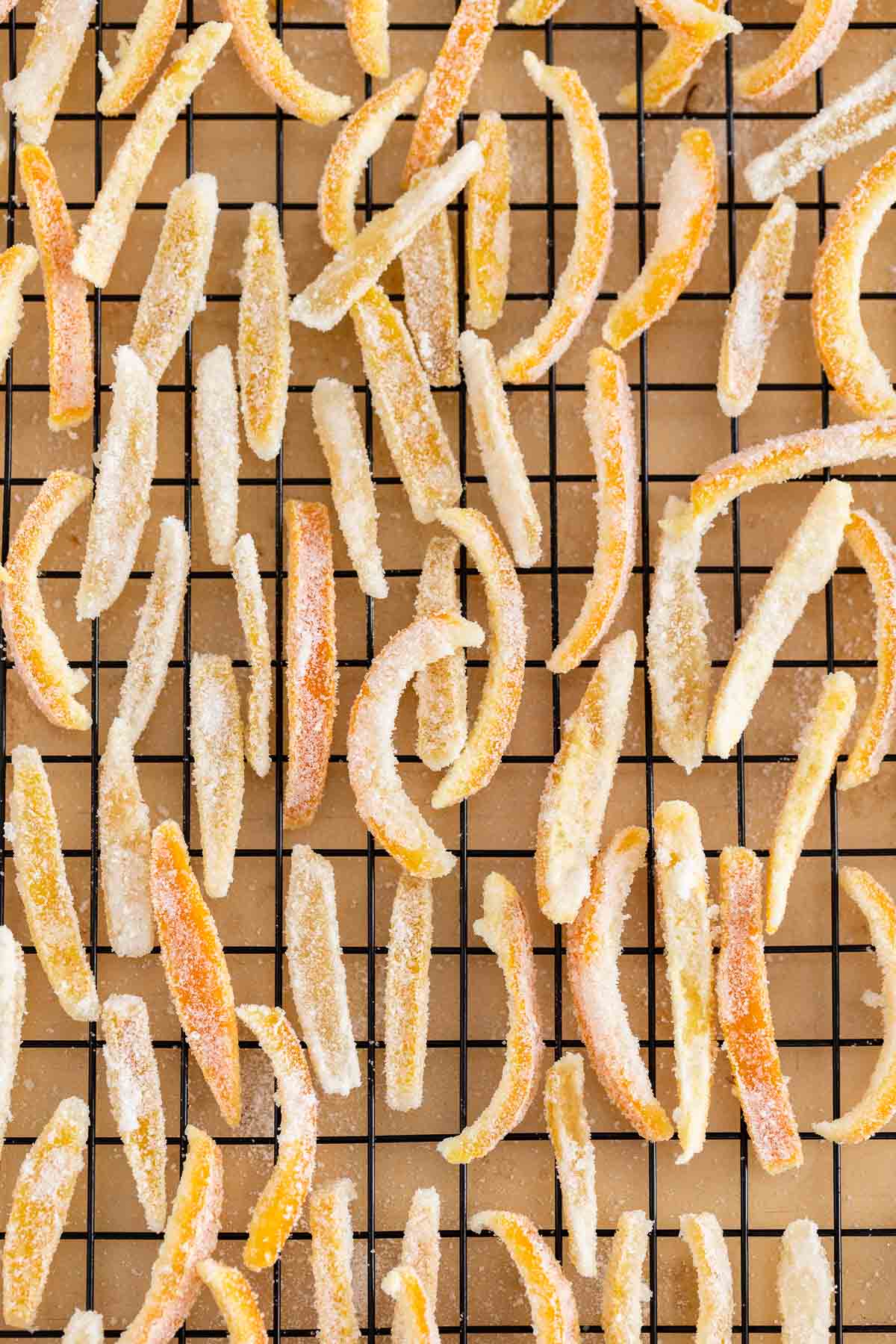
Recipe FAQs
The white part called the pith under the orange peel is what makes it bitter. Candied orange peel can come out bitter if you don’t blanch the peels multiple times. The blanching process reduces the bitterness.
No, you don’t need to refrigerate candied orange peels. Store them in an airtight container in a cool place, and they will keep for at least a month. If you don’t dry the peel completely, for example, if you want to use it for baking, I recommend storing it in the fridge.
Candied Peel is used in many German Christmas baking recipes. The most popular recipes are probably Lebkuchen and Stollen. But there are also lesser-known recipes like Fruchthaufchen (little fruit stacks), Florentiner cookies, and Stollenkonfekt.
Rolled in sugar, they make a delicious little treat. Dipping the candied peels in chocolate makes them an even more delicious treat.
The citrus syrup can also be used in many ways. You can use it to make drinks and cocktails. But it can also be used instead of honey in recipes or drizzled over oatmeal and yogurt.
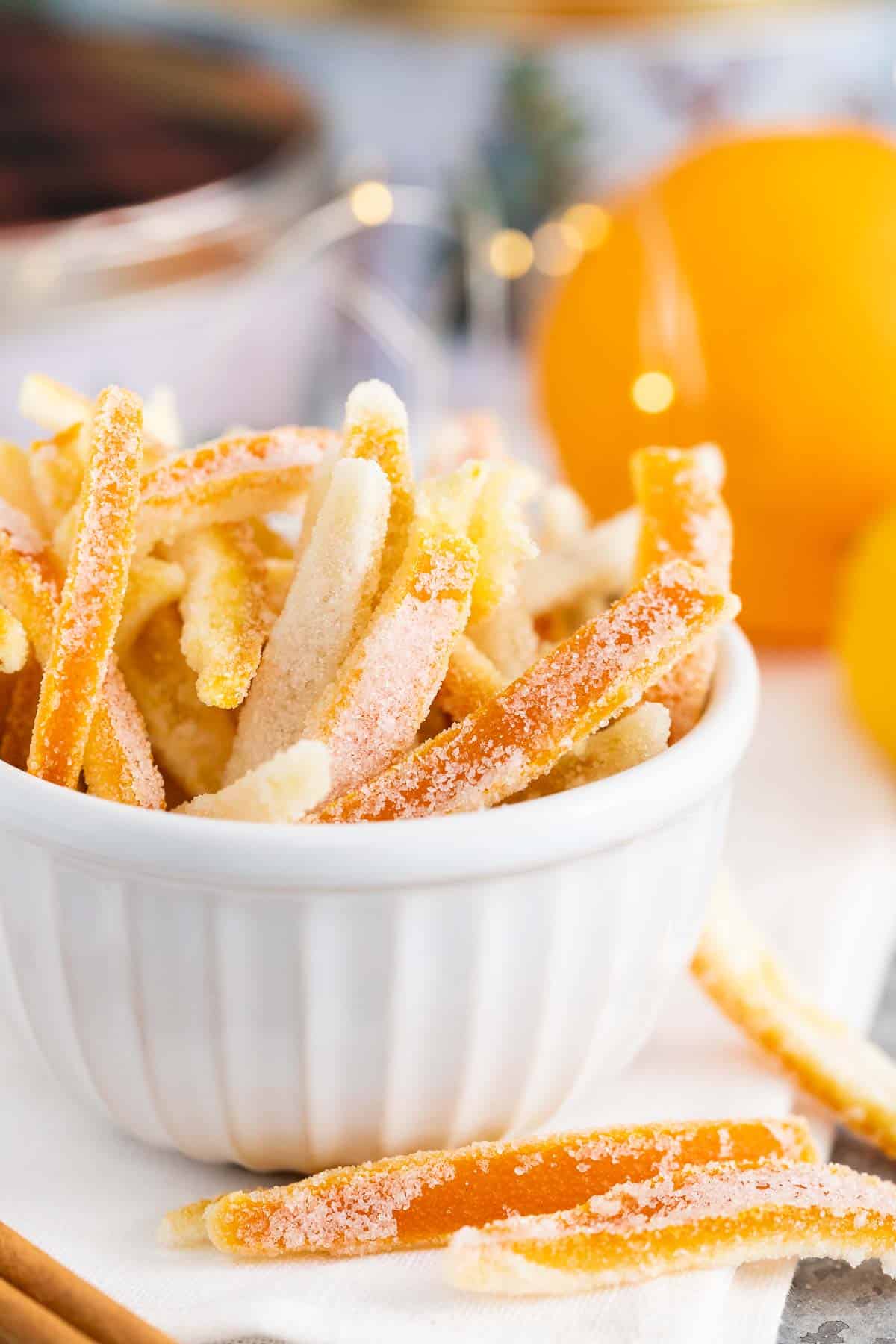
Storage
The candied citrus peels keep for at least a month stored in an airtight container or glass jar in a cool, dark spot. If you skip the coating in sugar, I recommend storing the peels in the fridge.
More German Christmas Recipes to Try
Christmas Recipes
Zimtsterne
Appetizer Recipes
Easy Cinnamon Candied Almonds
German Recipes
Kinderpunsch
German Recipes
The BEST German Christmas Cookies
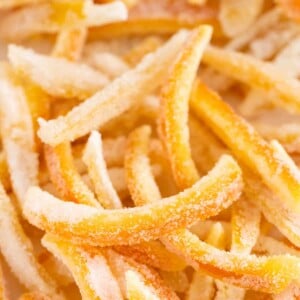
Candied Orange Peel (German Orangeat)
Ingredients
- 4 oranges
- 4 lemons
- 2 cups white sugar
- 1 cup water
For coating
- ⅓ cup white sugar, optional
Instructions
- Cut off the top and bottom of the oranges and lemons and score the peel in quarters. Gently peel the citrus fruits then cut the peels into strips about 1/4-inch wide.
- Place the strips in a medium saucepan, cover with cold water and bring to a boil. Boil them for 5 minutes then drain them in a colander and rinse them with cold water. Return the peels to the pot and repeat the process once or twice.
- In the same saucepan, combine 2 cups of sugar and 1 cup of water. Bring to a boil and cook until the sugar is dissolved. Then add the peels to the boiling sugar mixture, reduce the heat, and let simmer for about 60 minutes, stirring frequently, until the peels are translucent.
- Use a skimmer or slotted spoon to remove the peels, let excess syrup drip off, and spread them out on a wire rack to cool down for 1 hour.
- Then roll them in sugar or put them in a ziplock bag with the sugar and toss the bag until the peels are coated in sugar. This step can be skipped if you use the peels for baking.
- Spread candied peel out on a wire rack to dry for one or two days until they’re completely dry. Then store them in an airtight container.
Notes
- Citrus fruit: You can make this recipe with any citrus fruit. I use oranges and lemons. But it also works with limes and grapefruits.
- Blanching: Don’t skip blanching the peels! This process diminishes the bitterness of the pith, the white part of the peel, and also gives the final product a soft and chewy texture.
- Sugar mixture: You want the citrus peels to be covered with syrup. If your oranges are very large, and you have a lot of peel, you can increase the amount of water and sugar by the same ratio.
- Candy Thermometer: On a candy thermometer the target temperature of the sugar mixture is about 230 degrees F which is soft ball stage.
- Pith: Don’t remove too much of the pith because the thinner the peels, the harder and tough the candied orange will be. You want it to be slightly chewy.
- Leftover fruit: The peeled fruit can be used for eating or juicing, it is not needed for the recipe.
- Drying: It takes a few days until the peels are dry. I recommend turning them a once a day. You can also transfer them to a parchment paper-lined baking tray after they are cooled down.
- Baking: If you want to use the peel for baking, I recommend not rolling it in sugar. Just skip that step and let the peel dry until they are just dry enough.
- Syrup: The strained syrup is essentially a citrus-flavored simple syrup and can be used in your favorite drinks and cocktails. It also tastes delicious mixed with sparkling water.
